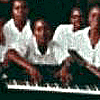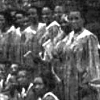| Tanzanian kwayas record kandas (audio
cassettes) for several reasons. The principle belief is
that the mass marketing of kandas allows a kwaya to reach
more people, to "send the message" where they
would not normally go. It is, therefore, an extraordinary
important tool for evangelization in contemporary East
African Christian churches. With the introduction of
popular kwaya music in the kanda market, a new form of
"mission" has begun to emerge. There is also a
great deal of prestige involved in recording and
producing a good quality kanda. For youth kwayas in
particular, recording and producing kandas of
"popular" kwaya music is becoming a prime mode
for attracting membership and drawing crowds at Sunday
services. The post-Uhuru (Independence) rise of "jazz" in the Christian churches in Tanzania reflects the growing participation of the young nation in the world market. Yet the position of the more popular styles of kwaya music is far from solid in contemporary East African churches. As one prominent leader of the Dar kwaya scene shared with me, there is still a problem with the acceptance of "jazz" as a truly "Christian" musical expression: Interview Aminieli Mkichwe
Roman Catholic churches in Tanzania have been slower to yield entry to the symbols of Western popular culture--electric guitars and keyboards--into their sanctuaries and services. Protestant churches, however, permitted the newer, popular forms of music, with only an initial show of objection and protest. Kwayas identifying with the progressive, popular music traditions specifically market themselves to the kanda-buying community by featuring their expensive electric instruments prominently on their kanda's jacket cover. Set One and Set Two photographs are covers of Tanzanian kwaya kandas. Set One |
|
| These two sets of kanda
covers illustrate the distinction. In the first three
covers, Casio keyboards and electric guitars are
displayed proudly, identifying for their market the
popular genre of music they specialize in, distinguishing
them from the more traditional kwaya repertoires
illustrated by the illustrations on the three kanda
covers of Set Two. The adoption of a new and different
visual image has been concomitant with and critical for
the development of popular kwaya music. 1a. Alileta Amani, volume one, Kwaya ya Vijana, Manzese Lutheran Church, Dar Es Salaam (electric guitars and keyboard are featured prominently). Cassette cover. 1b. Sikilizeni, Njombe Anglican Cathedral Choir, Nj'ombe (electric guitars, speakers, and keyboard). Cassette cover. 1c. Upepo, volume two, Mhimidini Choir, Iringa Town Choir, Iringa (guitars and keyboard). Cassette cover. |
|
| Set Two | |
| The second set of covers
demonstrates a visual re-affirmation of older kwaya
styles, more rooted in European than Tanzanian culture. 2.a Tangazeni Amani, volume four, Kwaya ya Kati na Vijana, Magomeni Lutheran Church, Dar Es Salaam (no instruments). Cassette cover. 2b. Pepo na Mawimbi Vyamsikiza, Kwaya Kuu, Lushoto Lutheran Church, Lushoto (songbooks featured prominently). Cassette cover. 2c. Pasaka: Kristu Mchindi Kafufuka, Kwaya Kuu ya Kristu Mfalme, Tabata Roman Catholic Church, Dar Es Salaam (European depiction of the resurrection). Cassette cover. |
|
Kwayas record and mix their
kandas in the same recording studios as the popular bands
in Dar Es Salaam. They hire the same engineers, the same
equipment, and often use the same instruments. At one
time in the not so distant past, all music groups, kwayas
included, recorded in the studio at Radio Tanzania Dar Es
Salaam (RTD). Kwayas contributed heavily to the early
recording schedules of RTD, frequently outnumbering
bands:
Today, there is a growing number of recording studios in the Dar Es Salaam area. These studios vary considerably as to quality and equipment. There is also a wide range in what the studios charge to record an individual kwaya kanda, with the quality of the final product not always in obvious indication of the expense involved. The Tanzanian Film Company (TFC), for example, charges over ten times more than the Don Bosco Recording Studio in Upanga.(3) Unfortunately, the original master tapes from each studio are usually subjected to the same processes of dubbing, using poor quality machines, so that by the time most kwaya kandas reach the streets there is little distinction in quality of the original recording. Kwaya kandas are sold at various locations. In the downtown Dar Es Salaam city center there are street kiosks that specialize in selling kwaya kandas exclusively. Most of the larger permanent street kiosks in Dar will, however, stock a representative sampling of kwaya kandas. In addition to the street kiosks, many churches in Dar feature temporary selling kiosks on church property every Sunday during times of services. Holiday times (Christmas and Easter) are prime opportunities to buy the latest kwaya kandas, since kwayas often time their recording sessions and the release of their kandas for these holiday periods. The sale of kwaya kandas is also a profitable business for non- Christian, Indian business people in Dar Es Salaam. The recording and production of kandas serve several purposes for Tanzanian kwayas. First and foremost is the preservation and documentation of musical repertoires. The Kijitonyama Lutheran Kwaya ya Usharika in Dar Es Salaam, for example, has recorded five volumes of kandas in an attempt at keeping up with their ever-expanding repertoire. Kwaya members and the congregations they minister to want to listen to their kwaya's hit tunes when they return home. In addition, kwayas also use their kandas as fundraisers to promote the activities of the kwaya. Probably most significant for many members of kwayas is the role kandas assume in the evangelizing effort of the church. The current popularization of kwaya music has enabled kwayas to "send their messages" beyond their home communities to a greater population. |





